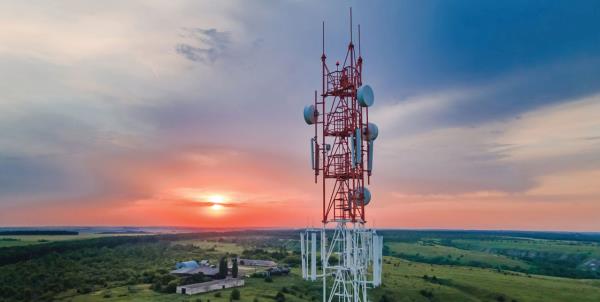05 May 2023

Enhancing tower operations is key to meeting global sustainability goals, increasing reliability and, of course, profitability. Amy Saunders finds out how towercos are advancing in an increasingly competitive landscape
Demand for mobile data is booming in developing world regions, with digital transformation accelerated hugely by the onset of the COVID-19 pandemic. Across Africa, mobile – as the dominant form of connectivity - was key to the pandemic response as services moved online.
However, “a key consideration in these regions is that mobile penetration remains low,” says Phillippe Loridon, regional CEO – Middle East, East & West Africa, Helios Towers. “Therefore, huge growth is expected, pushing our customers to further expand their networks by increasing capacity and coverage, and we need to be in a position to respond accordingly.”
There is an incredible rate of growth across Africa, agrees Andrew Schafer, CEO, PowerX Technologies, and “we cannot underestimate the pressure on the existing passive infrastructure. We see the effects already showing up in two distinct ways. On one hand, the power load on existing mobile towers is going up due to more mobile data connections and more access equipment. On the other hand, the pressure to deploy low-cost builds for more ultra-rural coverage is stress-testing traditional operational models.”
However, in an era of load-shedding and power station vandalism, reliable power provision remains a key challenge.
“Despite increasing investments in lower cost and greener energy, tower operators are struggling to fully realise the benefit and reduce the extent to which mobile connectivity continues to rely on expensive and dirty fossil fuels,” says Schafer. “Mobile use is still heavily powered by diesel use and so it is no surprise that sustainability in telecom in Africa is big on executives’ agendas.”
Indeed, sustainability remains a key priority for Helios Towers: “our ambition is to become a net zero carbon emissions business by 2040. All our budgets and forecasts now include carbon emissions to help understand the impact of business decisions on our 2030 carbon reduction target and net zero ambition,” says Loridon. “We also created a cross-functional working group including sustainability, finance, commercial, supply chain and compliance to promote climate action across the business.”
The conjoined challenges of rising demand, patchy power provision and a move towards sustainable operations are compounded by the fact that the industry has been running for years with business processes built around manual operations and inadequate data, as per Schafer.
“Too many operational inefficiencies still remain undetected, such as underutilised renewable assets, suboptimal power mix or sites under-dimensioned for the latest load increase,” asserts Schafer. “Too many field engineers are dispatched to towers without enough information on what issues they need to fix. We continue to see the challenges that companies running towers have in accessing reliable and actionable insights across the vast scale of the operations they manage.”
The industry needs a paradigm shift, says Schafer: priorities for field engineers, for operational and performance teams and for capital expenditure must be determined by leveraging the advanced data science technology that is becoming available to the industry.
“That’s what frames our own priority for the coming year: helping the industry adopt and widen the use cases where advanced data analytics, machine learning and automation surface hidden inefficiencies,” says Schafer. “It’s only by turning data into actionable insights automated through to resolution at scale that we enable networks to make existing and new renewable energy investments go further. We believe this approach needs to also bring other assets beyond power provision in scope, such as cooling, lighting, and active equipment. This will provide a holistic view to managing network infrastructure efficiently and to better plan for sustainable growth.”
Going green
Global movements towards creating more sustainable systems and infrastructure are as important in Africa as they are elsewhere. Towercos bear considerable responsibility in paving the way to a more sustainable future for telecoms on the continent.
“Telecom in Africa has been leading the way in adoption of renewable energy to power mobile infrastructure,” says Schafer. “However, despite significant investments in greener energy, the pace of mobile demand growth compounded by unresolved operational inefficiencies, make it impossible to reverse the extent to which mobile use in Africa is paradoxically still powered by diesel.”
As such, across the industry, it is important to find innovative ways to improve efficiencies at every corner, to decrease power consumption and emissions over time. “We have attempted to do this in several ways,” says Loridon. “One is that we have established a performance engineering team, which has helped us to reduce our carbon emissions and also committed $100 million across Project 100 focused on reducing our carbon.”
Another area is the continued evolution of battery technology. “Recently, we made the decision to move away from lead acid batteries and across to lithium-ion batteries. This is because we can operate them at higher temperatures than we see across Africa,” explains Loridon. “They have a longer life. So, we are using battery technology to reduce the amount of time the generators are running.”
Shifting the operational model to increase tower efficiency and optimise investments in renewables must go hand-in-hand with the industry’s response to increasing power needs and significant carbon reduction expectations.
“We have seen that where companies adopt technologies such as advanced data science and automation to digitise operations, it can improve utilisation of renewable assets by at least 10%,” reports Schafer. “The resultant impact, that can be realised only with data-led tower efficiency solutions, is diesel consumption reduction of typically 20-30%, together with the associated emissions reduction benefit.”
In addition to increasing efficiency through avenues such as power uptime, Helios Towers also invests in alternate power solutions to reduce the utilisation of fuel, which is not only the most carbon positive action, but also reduces the utilisation of the most expensive form of powering a site.
“As part of our CO2 targets and ambition to achieve net zero, today, 31% of our sites utilise either solar or hybrid,” says Loridon. “What we need to recognise as an industry, is that we need to work together if we want to achieve more. We have seen a step change in the collaboration with our customers as we recognise we have the same value chain, and we have been working together closely, particularly with one customer to evaluate what technology they have seen has worked and what technology we have seen has worked. It has been very interesting to see that we are actually looking at the same solutions.”
Schafer, meanwhile, believes that data intelligence is the answer to enhancing Africa’s tower efficiency. “We believe the industry can move to increased tower efficiency and sustainability at the core of its growth by adopting a systematic approach to leveraging data intelligence,” says Schafer.
That starts with detecting unseen infrastructure issues, then applying automation to triage and prioritise fixes or improvements across the full operations and maintenance lifecycle – from field engineers through to strategic business decisions.
“Leveraging advanced data analytics and automation is key to optimising operational processes and scaling improvements faster across large volumes of sites,” outlines Schafer. “Audit trails and reporting are fundamental to the process, supporting compliance and enabling measurement. This process leads to both internal and external benchmarking, delivering insights as to the performance of sites, operational teams, OEMs, and suppliers. This drives continuous improvement and ultimately leads to setting new industry standards in tower efficiency, ESG best practice and sustainable mobile growth.”
Improving operations
Uptime is crucially important to a towerco’s MNO partners because higher uptime means more time in which networks are powered, and therefore, more time in which they can generate revenues and serve consumers.
“To put this into perspective, each 1% of network downtime across our nine markets loses MNOs $175 million in annual revenues,” explains Loridon. “One of the key improvements we have made to improve efficiency has been improving our power uptime. Back in 2015, our customers were losing a lot of revenue. In Tanzania, it was 15 minutes of revenue lost per week per tower.”
Helios Towers made investments to reduce power downtime to less than one minute per week per tower in 2018 – today, that number is down to less than 30 seconds. “We’re now trying to replicate this success across our other markets, where on average we only get 16 hours of grid per day, and power uptime is critical for our customers,” adds Loridon.
Another route towards enhancing tower operational models is colocation and tower sharing, which has become in vogue in recent years as opex rises with inflation and energy costs.
“Our model is very simple,” explains Loridon. “We start with one tenant on it. Then we aim to put as many tenants on the site as possible, which we call colocation. And then we try and get those tenants to add more equipment over time, and we charge revenue for more equipment going on our sites.”
Each tower site runs at a fixed cost. Each time an incremental tenant is added, Helios Towers sees around 80% margin flow-through; the site ROIC jumps from 11% to 19% to 32% each time a new tenant comes on board.
“We have a saying at Helios - we are not a towerco, but we are a coloco,” adds Loridon. “We only own towers so that we can add multiple tenants to them because that is what drives value. Because our business model is to facilitate sharing of infrastructure rather than having lots of single mobile operator towers, we inherently drive carbon emission reduction.”
What does the future hold for Africa’s towercos?
The African telecommunications market is already booming amidst rampant population expansion, and things are only expected to heat up in the years to come.
Indeed, the GSMA reports that subscriber penetration in MENA is expected to grow from 54% in 2022 to 65% in 2030; 4G connections are expected to fall from 48% to 33% as 5G expands from 3% to 47% of all mobile connections. In sub-Saharan Africa, meanwhile, mobile subscriber penetration is forecast to expand from 43% in 2022 to 50% in 2030 - 4G will become the dominant mobile generation, growing in connections from 22% to 47%, although 5G connectivity will also expand from less than 1% to 16%.
“Our regions have the best growth dynamics by far anywhere in the world, and we believe that there will be plenty of structural growth for decades to come,” says Loridon. “So, whilst the rest of the world may be stagnating in terms of population growth, Africa and the Middle East are set to triple their populace in this century alone, and in fact, almost double it by 2050.”
Alongside this, Africa also has the fastest-growing mobile market, the highest rate of urbanisation and the fastest-growing economies. “Our countries contain five out of the top 10 most urbanised cities in the world. One of these cities, Kinshasa, the capital of DRC, today has 17 million people living within it. By 2035, it is forecast to have 27 million people. It will be the next global mega city, so watch this space. This city alone will need 5,000+ telecoms point as a service in getting to that size,” says Loridon.
Meanwhile, Schafer describes a trend in tower operators increasing their focus on efficiency and cost reduction, whilst trying to balance capacity and coverage growth and not compromise on resilience and SLA achievement.
“The increase in energy costs globally and the sustainability concerns drive the continuous need for more investment in renewables and specific actions to reduce GHG emissions,” concludes Schafer. “We have seen a clear acknowledgement that efficiencies cannot be achieved without leveraging data and making existing assets work harder. We therefore expect to see 2023-2024 become a pivotal year for tower companies investing in technologies that digitise their infrastructure to drive operational efficiencies and support the attainment of increasing stringent sustainability targets.”






